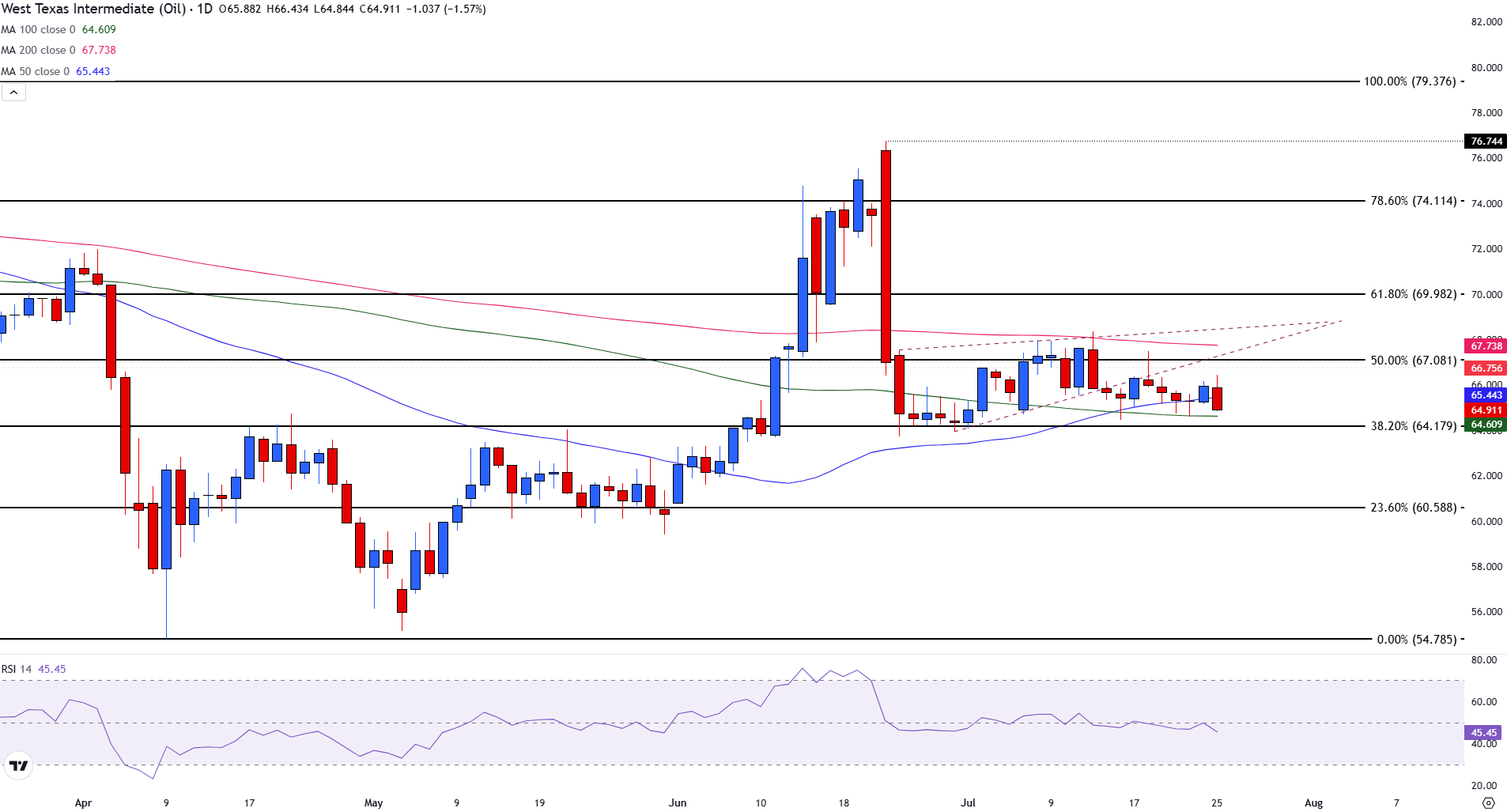- The West Texas Intermediate falls while Venezuela and OPEC+ increase concerns about excess supply.
- Clarity about commercial conversations between the US.-EE and the US.-China can guide the WTI address.
- WTI crude oil falls below $ 65.00 as the technical pressure aligns with the increase in the supply perspective.
The West Texas Intermediate (WTI) is under pressure on Friday as the markets respond to a growing global supply perspective and remain cautious about demand perspectives.
At the time of writing, the WTI is quoted below $ 65.00, with daily losses that exceed 1.50%.
The market is reacting to the possibility that Venezuela can resume oil exports, after the US decision to restore Chevron license to operate in the country.
The movement occurred after an exchange of high -profile prisoners that led to the release of ten US hostages. Under the revised authorization, Chevron can make restricted oil transactions by debt and resume contractors, without allowing a direct financial benefit to the Maduro regime.
Although immediate production gains are expected to be limited due to the weakened infrastructure of Venezuela, the movement reopens the door to a long -term significant supply potential. Venezuela has the largest tested crude oil reserves, and even a partial recovery could impact the dynamics of global supply.
The optimism about the ongoing commercial conversations between the US.-EE and the US.-China has helped raise the feeling of risk in general. But until clarity arises about negotiations, it is likely that WTI gains remain limited.
Meanwhile, the organization of oil exporting countries and its allies (OPEP+) is ready to increase production by 548,000 barrels per day (BPD) in August.
A follow -up meeting on August 3 is expected to confirm a similar increase for September.
The combination of the increase in OPEC+ production and the possible return of the Venezuelan supply is feeding concerns about excess supply.
These supply side risks currently exceed support factors, such as the improvement of demand indicators, stronger macroeconomic data and the decrease in commercial tensions.
WTI crude oil falls below $ 65.00 as the technical pressure is aligned with the increase in supply perspective
The WTI crude is quoted below $ 65, reinforcing the bearish tone as the foundations and technicians move in tandem.
The price has fallen decisively below the single mobile average (SMA) of 50 days at $ 65.44. Now he is pressing the key support in the 100 -day SMA ($ 64.61) and the 38.2% fibonacci setback in 64.18.
This confluence zone is critical. Not maintaining above this area would expose the minimum of June at $ 63.73, with a clean break that would point to the next important level of Fibonacci of 23.6% in 60.58 $.

WTI crude oil daily graphics
On the positive side, the resistance remains in the 50 -day SMA, followed by $ 66.75 and the 50% setback in $ 67.08.
The relative force index (RSI) in 46 indicates a weakening of the impulse, supporting the vision that the downward risks remain the focus as concerns about the offer weigh on the feeling.
WTI oil – frequent questions
WTI oil is a type of crude oil that is sold in international markets. WTI are the acronym of West Texas Intermediate, one of the three main types that include the Brent and Dubai’s crude. The WTI is also known as “light” and “sweet” by its relatively low gravity and sulfur content, respectively. It is considered high quality oil that is easily refined. It is obtained in the United States and is distributed through the Cushing Center, considered “the crossing of the world.” It is a reference for the oil market and the price of WTI is frequently traded in the media.
Like all assets, supply and demand are the main factors that determine the price of WTI oil. As such, global growth can be a driver of the increase in demand and vice versa in the case of weak global growth. Political instability, wars and sanctions can alter the offer and have an impact on prices. OPEC decisions, a group of large oil -producing countries, is another key price factor. The value of the US dollar influences the price of WTI crude oil, since oil is mainly traded in US dollars, so a weaker dollar can make oil more affordable and vice versa.
Weekly reports on oil inventories published by the American Petroleum Institute (API) and the Energy Information Agency (EIA) influence the price of WTI oil. Changes in inventories reflect the fluctuation of supply and demand. If the data show a decrease in inventories, it can indicate an increase in demand, which would raise the price of oil. An increase in inventories may reflect an increase in supply, which makes prices lower. The API report is published every Tuesday and that of the EIA the next day. Their results are usually similar, with a 1% difference between them 75% of the time. EIA data is considered more reliable, since it is a government agency.
The OPEC (Organization of Petroleum Exporting Countries) is a group of 13 nations oil producing that collectively decide the production quotas of member countries in biannual meetings. Their decisions usually influence WTI oil prices. When OPEC decides to reduce fees, it can restrict the supply and raise oil prices. When OPEC increases production, the opposite effect occurs. The OPEC+ is an expanded group that includes another ten non -members of the OPEC, among which Russia stands out.
Source: Fx Street
I am Joshua Winder, a senior-level journalist and editor at World Stock Market. I specialize in covering news related to the stock market and economic trends. With more than 8 years of experience in this field, I have become an expert in financial reporting.







